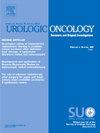Survival outcomes for men with metastatic castration-resistant prostate cancer (mCRPC) with and without homologous recombination deficiencies (HRD) treated with radium 223: Princess Margaret Cancer Centre (PMCC) experience
IF 2.3
3区 医学
Q3 ONCOLOGY
Urologic Oncology-seminars and Original Investigations
Pub Date : 2025-07-08
DOI:10.1016/j.urolonc.2025.06.004
引用次数: 0
Abstract
Background
Radium-223 (223Ra) targets bone metastases in metastatic castration resistant prostate cancer (mCRPC) and induces double-strand DNA breaks. We hypothesized that patients with homologous recombination deficiencies (HRD) may exhibit heightened sensitivity to 223Ra, resulting in improved survival outcomes.
Methods
This retrospective analysis was performed in men with mCRPC and bone metastases, with and without HRD, treated with androgen deprivation therapy (ADT) and 223Ra at the PMCC. Demographics, disease characteristics, and/or somatic DNA sequencing data were collected.
Results
Between 2015 and 2022, we identified 40 mCRPC patients who underwent 223Ra therapy and had germline and/or somatic DNA sequencing data available. HRD mutations were found in 9/40 (22.5%) patients. Median overall survival was longer in the HRD group vs. non-HRD group (24 vs 12 months; p = 0.038). Median progression-free survival was 5.7 vs. 3.3 months (P = 0.74). PSA response was also higher in the HRD group (33.3% vs. 9.7%; P = 0.11), as was ALP response (66.7% vs. 58.1%; p = 0.72). Among patients with an ALP response, 3-year survival probability was 33% in the HRD group vs 11% in the non-HRD group (P = 0.03).
Conclusions
Despite the small size, these findings suggest that patient with HRD may have a slight improvement in survival outcomes after 223Ra treatment, but prospective validation is required.
伴有或不伴有同源重组缺陷(HRD)的转移性去雄抵抗性前列腺癌(mCRPC)患者接受镭223治疗的生存结局:玛格丽特公主癌症中心(PMCC)的经验。
背景:镭-223 (223Ra)靶向转移性去势抵抗性前列腺癌(mCRPC)的骨转移并诱导双链DNA断裂。我们假设同源重组缺陷(HRD)患者可能对223Ra表现出更高的敏感性,从而改善生存结果。方法:回顾性分析伴有或不伴有HRD的mCRPC和骨转移患者,在PMCC接受雄激素剥夺疗法(ADT)和223Ra治疗。收集人口统计学、疾病特征和/或体细胞DNA测序数据。结果:在2015年至2022年期间,我们确定了40例接受223Ra治疗的mCRPC患者,并获得了生殖系和/或体细胞DNA测序数据。在9/40(22.5%)的患者中发现HRD突变。HRD组的中位总生存期比非HRD组更长(24个月vs 12个月;P = 0.038)。中位无进展生存期为5.7个月对3.3个月(P = 0.74)。HRD组的PSA反应也更高(33.3% vs. 9.7%;P = 0.11), ALP反应(66.7% vs. 58.1%;P = 0.72)。在有ALP反应的患者中,HRD组的3年生存率为33%,而非HRD组为11% (P = 0.03)。结论:尽管研究规模较小,但这些发现表明HRD患者在接受223Ra治疗后可能有轻微的生存改善,但需要前瞻性验证。
本文章由计算机程序翻译,如有差异,请以英文原文为准。
求助全文
约1分钟内获得全文
求助全文
来源期刊
CiteScore
4.80
自引率
3.70%
发文量
297
审稿时长
7.6 weeks
期刊介绍:
Urologic Oncology: Seminars and Original Investigations is the official journal of the Society of Urologic Oncology. The journal publishes practical, timely, and relevant clinical and basic science research articles which address any aspect of urologic oncology. Each issue comprises original research, news and topics, survey articles providing short commentaries on other important articles in the urologic oncology literature, and reviews including an in-depth Seminar examining a specific clinical dilemma. The journal periodically publishes supplement issues devoted to areas of current interest to the urologic oncology community. Articles published are of interest to researchers and the clinicians involved in the practice of urologic oncology including urologists, oncologists, and radiologists.

 求助内容:
求助内容: 应助结果提醒方式:
应助结果提醒方式:


